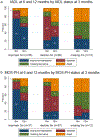Patterns and Predictors of Functional Decline after Allogeneic Hematopoietic Cell Transplantation in Older Adults
- PMID: 35247612
- PMCID: PMC9198006
- DOI: 10.1016/j.jtct.2022.02.022
Patterns and Predictors of Functional Decline after Allogeneic Hematopoietic Cell Transplantation in Older Adults
Abstract
As allogeneic hematopoietic cell transplantation (alloHCT) is increasingly offered to older adults, geriatric assessment (GA) has been identified as a useful tool for predicting outcomes, particularly functional status. However, very few studies have examined the longitudinal change in GA measures in the post-alloHCT period. The objectives of this study were to describe the longitudinal change in GA and quality of life (QoL) measures after alloHCT and to identify predictors of greater functional decline post-transplantation. In this single-center prospective cohort study, patients age ≥50 years scheduled for alloHCT completed a cancer-specific GA and the Functional Assessment of Cancer Therapy-Bone Marrow Transplant (FACT-BMT) survey at baseline prior to alloHCT and then at 3, 6, and 12 months post-transplantation. Changes in GA and QoL measures at each post-transplantation time point (3, 6, and 12 months) compared to baseline were analyzed using paired t-tests. Exploration of potential predictors of greater post-transplantation functional decline, as measured by instrumental activities of daily living (IADL) and the Medical Outcomes Study Physical Health scale (MOS-PH), were examined using linear regression and the chi-square 2-sample test of proportions. Mean functional status generally exhibited a pattern of decline at 3 to 6 months post-alloHCT, with recovery to near baseline by 12 months. Mean mental health and emotional QoL were lowest at baseline and improved at all post-transplantation time points. Differences in baseline clinical characteristics were not associated with any differences in functional trajectories. Differences in baseline GA measures-patient-rated Karnofsky Performance Status, IADL, MOS-PH, Timed-Up-and-Go, Blessed Orientation-Memory-Concentration test, and Mental Health Inventory 5-also did not predict greater functional decline at 3 months. Patients whose IADL was improved or maintained at 3 months generally maintained their functional status at 6 and 12 months. Similarly, most patients who had an IADL decline at 3 months still had a functional decline at 6 months, although a proportion did have functional recovery by 12 months. Compared with patients who had improved/maintained IADL at 3 months, those with a decline in IADL at 3 months were significantly more likely to have persistent functional decline at 6 months (P < .0001) and 12 months (P = .02). In older alloHCT recipients, mean functional status declines short term after alloHCT with the possibility of recovery by 6 to 12 months, whereas mean mental and emotional health improve post-alloHCT. Functional decline at 3 months post-alloHCT is associated with persistent functional decline at 12 months.
Keywords: Allogeneic transplant; Functional status; Geriatric assessment; Older adults.
Copyright © 2022 The American Society for Transplantation and Cellular Therapy. Published by Elsevier Inc. All rights reserved.
Conflict of interest statement
Figures




Similar articles
-
Functional Status as Measured by Geriatric Assessment Predicts Inferior Survival in Older Allogeneic Hematopoietic Cell Transplantation Recipients.Biol Blood Marrow Transplant. 2020 Jan;26(1):189-196. doi: 10.1016/j.bbmt.2019.08.022. Epub 2019 Sep 5. Biol Blood Marrow Transplant. 2020. PMID: 31493541 Free PMC article. Clinical Trial.
-
Geriatric assessment in older alloHCT recipients: association of functional and cognitive impairment with outcomes.Blood Adv. 2020 Jun 23;4(12):2810-2820. doi: 10.1182/bloodadvances.2020001719. Blood Adv. 2020. PMID: 32574365 Free PMC article.
-
Association of geriatric measures and global frailty with cognitive decline after allogeneic hematopoietic cell transplantation in older adults.J Geriatr Oncol. 2023 Nov;14(8):101623. doi: 10.1016/j.jgo.2023.101623. Epub 2023 Sep 6. J Geriatr Oncol. 2023. PMID: 37678052 Free PMC article.
-
Delivering intensive therapies to older adults with hematologic malignancies: strategies to personalize care.Blood. 2019 Dec 5;134(23):2013-2021. doi: 10.1182/blood.2019001300. Blood. 2019. PMID: 31805199 Review.
-
The sum of the parts: what we can and cannot learn from comorbidity scores in allogeneic transplantation.Hematology Am Soc Hematol Educ Program. 2023 Dec 8;2023(1):715-722. doi: 10.1182/hematology.2023000458. Hematology Am Soc Hematol Educ Program. 2023. PMID: 38066892 Free PMC article. Review.
Cited by
-
Transplantation and Cellular Therapy for Older Adults-The MSK Approach.Curr Hematol Malig Rep. 2024 Apr;19(2):82-91. doi: 10.1007/s11899-024-00725-y. Epub 2024 Feb 9. Curr Hematol Malig Rep. 2024. PMID: 38332462 Free PMC article. Review.
-
How old is too old? Frailty and geriatric assessments of older patients undergoing allogeneic HCT.Hematology Am Soc Hematol Educ Program. 2023 Dec 8;2023(1):709-714. doi: 10.1182/hematology.2023000457. Hematology Am Soc Hematol Educ Program. 2023. PMID: 38066893 Free PMC article.
References
-
- Current use and outcome of hematopoietic stem cell transplantation: CIBMTR US summary slides. 2020.
-
- Devine SM, Owzar K, Blum W, et al. Phase II Study of Allogeneic Transplantation for Older Patients With Acute Myeloid Leukemia in First Complete Remission Using a Reduced-Intensity Conditioning Regimen: Results From Cancer and Leukemia Group B 100103 (Alliance for Clinical Trials in Oncology)/Blood and Marrow Transplant Clinical Trial Network 0502. Journal of clinical oncology : official journal of the American Society of Clinical Oncology 2015;33:4167–75. - PMC - PubMed
-
- Ringdén O, Boumendil A, Labopin M, et al. Outcome of Allogeneic Hematopoietic Stem Cell Transplantation in Patients Age >69 Years with Acute Myelogenous Leukemia: On Behalf of the Acute Leukemia Working Party of the European Society for Blood and Marrow Transplantation. Biology of blood and marrow transplantation : journal of the American Society for Blood and Marrow Transplantation 2019;25:1975–83. - PubMed
Publication types
MeSH terms
Grants and funding
LinkOut - more resources
Full Text Sources
Medical
Research Materials

